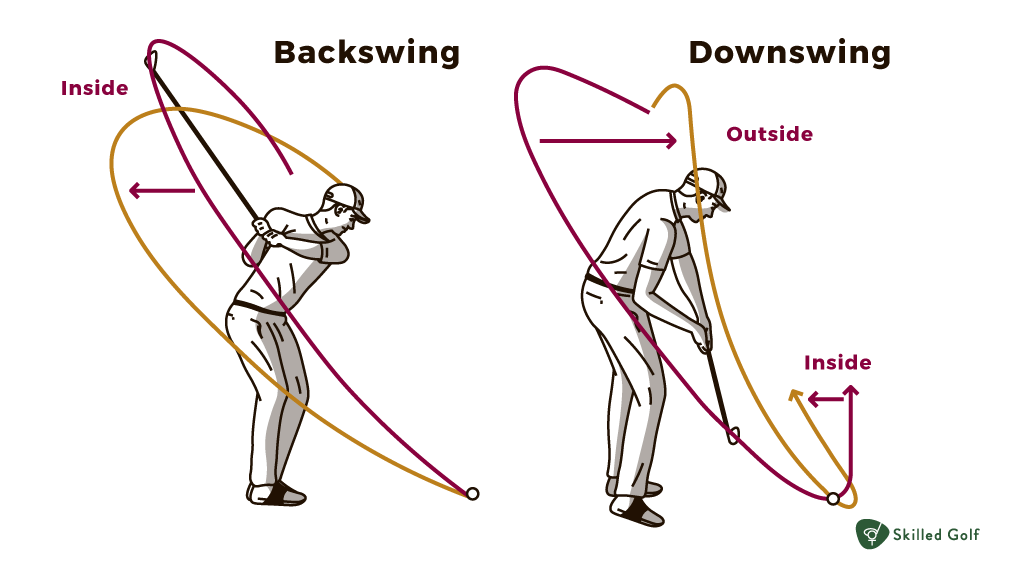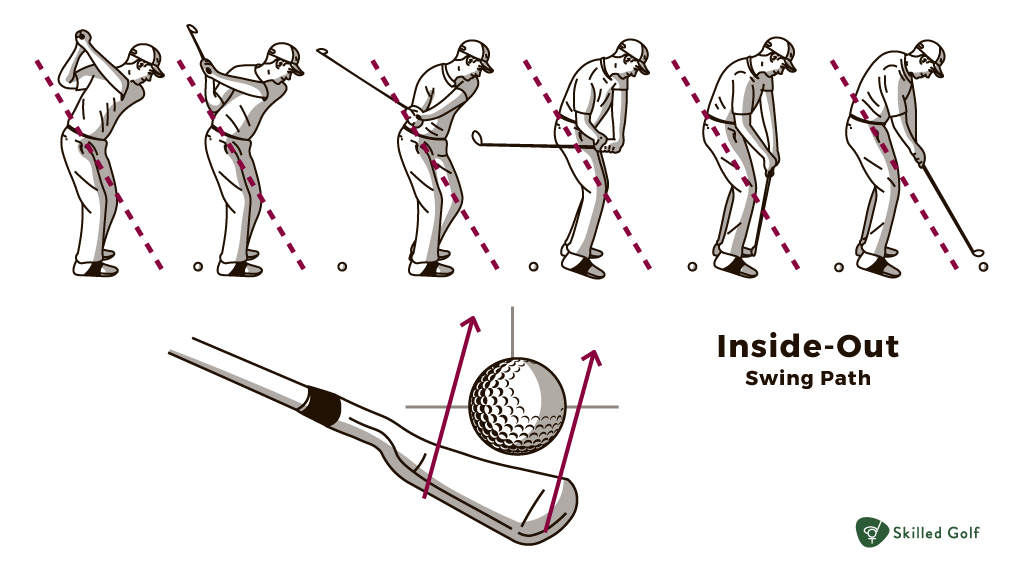One of the many things I have noticed as a golf professional is that people understand they want an inside out golf swing, but very few are able to pull it off.
For some people, this is simply because of a lack of understanding of the concept. If you want to start to swing from the inside out, you have to understand how it works and have to get on the right path.
In our guide, we will give you everything you need to know about an inside out golf swing.
What Is An Inside Out Golf Swing
An inside out golf swing is a way to describe a path that a golf club is on as it comes through the impact position. When a golfer swings from the inside out, they are setting themselves up to have much more control over the golf ball.
If you imagine a line that goes straight through the golf ball and all the way to the target and extends for a length past the ball as well, consider this a straight path.
When a golfer swings from the inside out, they will approach the ball slightly inside of this straight line.
As the golfer swings through the ball with the golf club, the club will extend slightly outside the line before it is wrapped around to complete the follow-through.
The move of an inside out golf swing is very subtle. You won’t feel as though the club is on a very unique or different club path.
Many people say they feel as though the club dropped into the “slot.” This is simply because when a golfer swings from the inside and extends the club out, the shot will feel very easy to hit.
If you can get your club to repeat this inside out swing continually, there will be many benefits.
Why To Swing Inside Out?
When a club swings from the inside out, there are quite a few good things that can happen. Here are the most important.

More Distance
When you swing with an inside out swing, you are going to make better contact with the golf ball. This better contact and straighter shot is going to have you hit the golf ball quite a bit further.
Golfers will notice a significant increase in distance when they use an inside out swing as compared to a club coming from the outside or even straight down the line.
Consistency
When you swing from the inside out, the club is usually more connected to the body.
The right arm and elbow are tucked in, and the club will not move out away from the body. Since the elbow is tucked in and has to be more connected to the larger muscles, the golf swing tends to be more consistent.
When the club gets out and away from the body, it is hard to get as consistent. Anytime the smaller muscles in the body are more involved in the golf swing, they will have a harder time repeating the action.
When they separate from the body and get on their own swing path, that is when you start to see quite a few slices and fades.
Control Of the Ball
Lower handicap golfers want the ability to hit a draw, a fade, a slice, and more. However, they want to hit these types of shots on command. This can be difficult for those that are not using the inside out swing.
When you swing the club from the inside, you will have much more control over the club face and what it is doing at impact. Therefore if you want to hit shots that go left to right or right to left, you can do so with a slight manipulation of the club face.
Keeping the path consistent and changing the face slightly is a great way to work the ball and hit controlled golf shots.

How To Hit The Ball Inside Out
Now that you know all these great things about this inside swing, you may be wondering how you can start swinging like this.
A few parts of the golf swing need to be in place and functioning properly before you can accomplish the inside out swing.
Takeaway
Starting your swing with a proper takeaway is going to be much easier for you to get the club on the inside swing path. When you take the club back, keep it low to the ground and do it slowly.
Incorporate a shoulder turn and make sure that your body is rotating. As you do this, the club will start to come slightly inside and head to the proper position.
Transition
Depending on the golf swing type you have, you may have some work to do at the top of your golf swing. For players that take the club back more shallow, you will just have to drop the club into the slot.
This will feel like your right elbow is sort of dropping into your side. From this position, you can really just attack the ball.
You are in the perfect spot to swing the club out and down the target line. This position also allows for more extension in the arms, which will help to increase the distance a player can get with their swing.
If you are a player who takes the club back on a more upright plane, you may feel as though you have to reroute the club a bit at the top to get it in the right place. It may take a bit of golf instruction to get your club in the right place to drop down and to the inside.
When your club is over the plane line, there is no way to hit from the inside out.
Downswing
Once your club has dropped into that spot, you should have no problem completing your downswing and sending the club out towards the target line.
You will know that the club is in the right place because your shot will very lightly start slightly right of the target and draw back in. A draw is the traditional ball flight of a player with an inside out golf swing.
Drills for Inside Out Golf Swing
By now, you should have a decent understanding of what it takes to hit a ball with a golf swing that comes from the inside. Again, this is going to be more of a feeling than any sort of dramatic movement of your club.
However, in order to get this feeling down and understand what the impact position will look like, you need to have some practice.
Luckily there are quite a few drills that work for this concept. Here are a few of our favorites.
Headcover Drill
When you are completing the headcover drill, you will need a headcover that does not have anything hard or metal on it. Choose something of substantial size but make sure that it is quite soft. Some people will do this drill with a water bottle, but we like the headcover.
Take the headcover and place it on the outside of the golf ball. If you are looking down at the ball, the headcover will be on the right side of the ball (prior to impact).
This is not just a great visualization, but it also will work to train your swing. Now you can take shots and try and avoid hitting the headcover. If you make contact with the headcover, then you know that the club has come from the outside as opposed to the inside.
You will have to spend some time practicing to get this feeling. What we love most about this particular drill is that it gives you a great visual outlook and helps you feel the move as well.
Towel Drill
For this drill, you will need a small golf towel. Take the towel and place it under your right arm. Setup to hit the ball; the towel should be help up in the armpit of your right arm. As you swing, the towel should stay in place on the way back and, most importantly, on the way down.
As golfers make the transition at the top of the backswing, many of them allow the towel to fall and drop to the ground. When this happens, the arm has separated from the body, and the club is not very likely on an outside swing path. Recovering once this happens is not going to be possible.
If the towel drops during your swing, chances are you are going to hit a shot that goes right or has a severe pull to the left. Both are misses that most golfers would rather avoid.
If you feel like you can only take a ¾ type golf swing with the towel in, that is completely acceptable. The idea is to help a golfer feel more connected so that they can swing from the inside.
Visualize the Target Line
Many golf drills are simply about visualization. Visualization in golf is very powerful, and without the right thoughts, the concept may never work for a player. One very strong visual tool is to think about and visualize the target line when you are at the top of your swing.
When you swing inside out, you can think about throwing the club slightly right of the target and allowing your arms to extend. Many golfers get hung up on the idea of hitting the ball and forget to think about what happens after contact is made with the golf ball.
This concept of swinging slightly right of the target and then allowing your hands to come up and over your left shoulder (for the right handed player) is a very solid thought to have during your swing.
Extension Drill
Last but certainly not least is a drill to practice extension. This is a simple drill, and all it involves is the player taking some slow swings with their right arm only.
When you do this, you focus on feeling the club stay connected in the backswing, close on the downswing, and then throw it out towards the target as part of the impact and follow through.
Sometimes when you remove the other arm from the equation, it becomes simpler to focus, and players can start to feel the path that the club and the ball should be on. You can do this with or without hitting a ball; we mostly recommend doing it without hitting a ball.
Common Mistakes and How to Avoid Them
Warning signs in golf come in all shapes and sizes. The most obvious are losing balls, missing fairways, and not knowing which direction you might miss. More subtle clues you’re in need of a swing correction are finishing off balance and varying distances your ball moves left to right or right to left.
In golf, knowing a problem exists is a fraction of what’s needed to fix something. So how do you improve? Knowledge, practice, and execution.
Recognizing and correcting slicing
A push is when the ball begins right of your target line and continues away. A slice starts left of your target line before cutting hard in the opposite direction and ends much further right.
Most slices happen because of an outside to inside swing path and open clubface. To remedy a slice, you need to work on both components.
Before completing a full swing transformation, those struggling should first focus on straightening their angle of attack to reduce spin. From there, you can go on and work towards more precise ball shaping. But without a reliable shot to fall back on, you will miss left and right.
Unfortunately, correcting a slice is not the easiest of feats and ranks high among frustrating things for golfers. It could be your grip, takeaway, follow-through, or any number of other details.
Slow your swing down, focus on precise movements in practice swings, and hit those spots in your normal swing. You can build back up after seeing results. The temporary loss of distance from reducing swing speed will be well worth the improved control you’ll see when your slice disappears.
Ensuring proper weight transfer and rotation
A good inside out golf swing requires your hips and shoulders to move together as a unit. Either one of these being ahead of the other leads to trouble.
Start your downswing with a first movement led by hip turn or dropping your shoulders and the ball could go anywhere. High, low, left, right—doesn’t matter. Over aggressive with your arms and you lose significant power, and again, will spray the ball. When these two things move as one, you’re able to keep the clubface square and your line of attack will be consistent.
If you have this part of your swing locked down and are still not seeing results, the problem is likely your setup.
Your back shoulder should be slightly lower than your front, but not too low. Too steep of an incline leads to pulls. Additionally, your hips should be slightly closed, but this is the direction your swing path should be on. Match your shoulders with this directional angle as well. Again, just a slight angle change.
Equipment That Can Help
Practice equipment and drills are more valuable than any one type of club will be for pushing your swing inside out. It’s on the range you’ll perfect a golf inside out swing, not on the course or by purchasing a new club.
Alignment sticks are some of the simplest, least expensive, and unassuming pieces of equipment a golfer can find. They’re also among the most effective. You can use them laid across the ground or facing upright for swing path drills.
Another great tool is a mat that provides swing path feedback. You place the ball on top of the mat with all the fabric brushed from front to back. When your club makes contact with the mat going back to front, it reveals your swing path at impact. It won’t fix your swing but provides feedback as to how close or far off you are.
This third option doesn’t require anything you don’t already have in your bag. Place a golf ball directly behind your clubhead before takeaway. When you start your swing, you will push the ball in the direction you take the club away. Pushing the ball away from your body? You’re starting an outside to in swing. Pull it closer to your body? You’re on the way to a golf inside out swing.
Frequently Asked Questions
Conclusion
Hopefully, you now have a much better understanding and concept of what an inside out golf swing is. Getting used to the inside out path takes a little bit of time.
However, once you get this concept down, your golf game will get considerably more consistent, and you will understand why this is something that all of the golf pros do.


